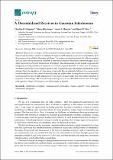A Decentralized Receiver in Gaussian Interference
Author(s)
Chapman, Christian D.; Mittelmann, Hans; Bliss, Daniel W.; Margetts, Adam R.
Downloadentropy-20-00269.pdf (410.4Kb)
PUBLISHER_CC
Publisher with Creative Commons License
Creative Commons Attribution
Terms of use
Metadata
Show full item recordAbstract
Bounds are developed on the maximum communications rate between a transmitter and a fusion node aided by a cluster of distributed receivers with limited resources for cooperation, all in the presence of an additive Gaussian interferer. The receivers cannot communicate with one another and can only convey processed versions of their observations to the fusion center through a Local Array Network (LAN) with limited total throughput. The effectiveness of each bound’s approach for mitigating a strong interferer is assessed over a wide range of channels. It is seen that, if resources are shared effectively, even a simple quantize-and-forward strategy can mitigate an interferer 20 dB stronger than the signal in a diverse range of spatially Ricean channels. Monte-Carlo experiments for the bounds reveal that, while achievable rates are stable when varying the receiver’s observed scattered-path to line-of-sight signal power, the receivers must adapt how they share resources in response to this change. The bounds analyzed are proven to be achievable and are seen to be tight with capacity when LAN resources are either ample or limited. Keywords: distributed reception; communications networks; channel capacity; relay channels; interference mitigation
Date issued
2018-04Department
Lincoln LaboratoryJournal
Entropy
Publisher
Multidisciplinary Digital Publishing Institute
Citation
Chapman, Christian, et al. “A Decentralized Receiver in Gaussian Interference.” Entropy, vol. 20, no. 4, Apr. 2018, p. 269.
Version: Final published version
ISSN
1099-4300